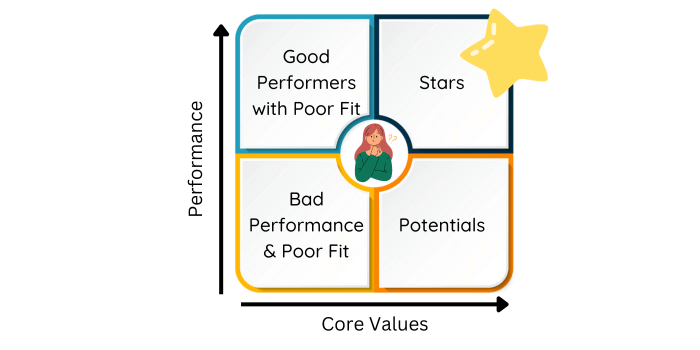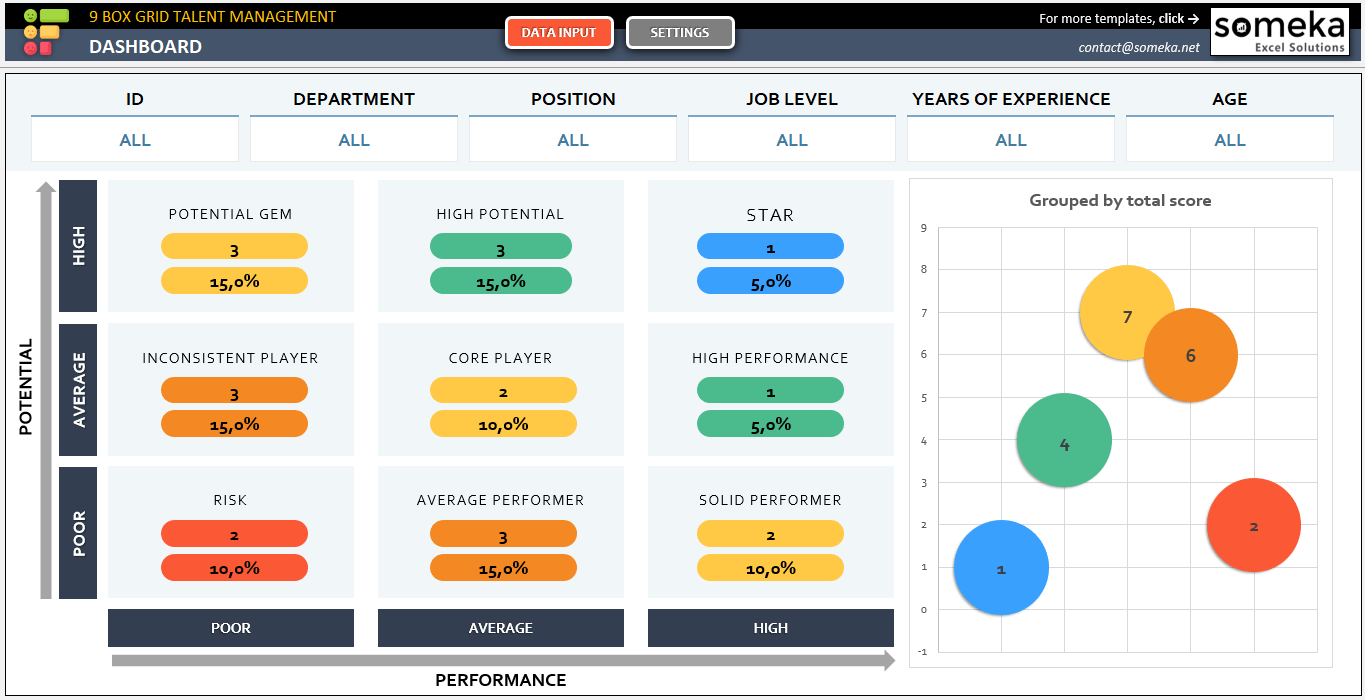
Performance-Values Matrix and 9 Box Grids: Comparison for Quadrant Models
You have probably using or at least heard about quadrant tools in talent management. They are based on placing employees in different categories according to their performance or potential or alignment levels. And of course the 9-Box Grid and Performance-Values Matrix are among such strategic tools.
In this article we’ll try to discover how to use 9 box grid and Performance-Values Matrix with tips, pros and cons.
Table Of Content
1. Four Quadrants Employee Performance
2. Values-Based Management Model (VBM)
3. Performance-Values Matrix Model (PVM)
4. The Jack Welch Performance-Values Matrix
5. How to use 9 Box Grid and Performance-Values Matrix?
6. VBM vs PVM: A Comparison
7. Last Words
8. FAQ’s
1. Four Quadrants Employee Performance
The idea behind the quadrant-style performance evaluation tools is to divide employees into four separate quadrants. This helps with talent management and performance evaluation. The classification is a useful way for HR staff and business leaders to learn more about their employees.

The Performance-Values Matrix is built on understanding these four quadrants, which also help HR professionals and leaders make strategic choices about how to manage talent. In the parts that follow, we’ll look at different models and approaches within this matrix. This will help you understand how businesses can use this tool to evaluate performance and help employees grow.
The number of quadrants may change. For example 9 Box model depends on nine boxes format. However, there are companies using 4×4 or 4×3 models according to their particular needs.
2. Values-Based Management Model (VBM)
Values-Based Management, or VBM, is a way of thinking and acting that focuses on making sure that an organization’s beliefs and how its employees act are in line with each other. The 9 Box Performance Values Matrix (PVM) is built on this model.
Understanding Values-Based Management (VBM):
VBM is a way of managing that focuses on building a company culture based on shared beliefs. It understands that an organization’s success isn’t just based on how well it does financially, but also on how well its values match up with those of its employees. These are the main ideas that VBM is based on:
- Finding Core Values: The first step in VBM is to find the organization’s core values, which shape its culture and ethos. People in the company use these beliefs to help them make decisions, act, and talk to each other.
- Values Alignment: One of the most important parts of VBM is making sure that employees’ actions and behaviors are in line with the company’s core beliefs. To do this, you need to hire, train, and keep employees who share these beliefs.
- Employee Engagement: VBM helps workers feel like they own their work and are committed to it. When workers believe in and live by the company’s values, they are more likely to do a good job in their jobs.
- Identity of the Organization: VBM helps form and strengthen the identity of the organization. It tells people inside and outside the company what it stands for and what it believes in.
What Does VBM Do in the 9 Box Performance Values Matrix?
In the 9 Box PVM, VBM is what is used to measure how well employees are performing and how well their values are aligned. The VBM model helps HR professionals and leaders figure out how well employees live up to the core ideals of the company while also meeting their performance goals.
When organizations use VBM concepts in their talent management, they can:
- Identify Values Alignment
- Guide growth
- Support Decision-Making
- Strengthen Organizational Culture
In the next few parts, we’ll talk more about the Performance-Values Matrix (PVM) and how it puts Values-Based Management into practice.
 10. What Are 9 Box Alternatives?
10. What Are 9 Box Alternatives?
3. Performance-Values Matrix Model (PVM)
The Performance-Values Matrix (PVM) is a powerful tool that helps align employee success with their values. Organizations can use it to evaluate the quantitative and qualitative efforts of their employees in a structured way.
Understanding the Performance-Values Matrix (PVM)
The PVM is a graph that divides employees into four groups based on how well their performance and values match up. By looking at both what employees do and how they do it, it gives a more complete picture of what they contribute.
Companies rate workers based on set performance standards and how well they show the company’s values. This information is then put into the PVM. Self-evaluations, manager evaluations, peer comments, and observations can all be used in this evaluation.
– This is the grid format from 9 Box Google Sheets Template created by Someka –
Why the Performance-Values Matrix (PVM) is useful
We can summarize the benefits of performance-values matrix in four main categories:
- Holistic Assessment: The PVM looks at both numeric and qualitative factors to get a full picture of what each employee has done.
- Talent Development: It helps you figure out what areas of improvement your employees need, like coaching or training to boost their performance or make sure their values are aligned with yours.
- Strategic Decision-Making: PVM assessments can help organizations make strategic HR choices about things like how to assign talent, how to plan for succession, and who to promote.
- Reinforcing the desired organizational culture: The PVM helps reinforce the desired organizational culture by recognizing and rewarding workers who live by the company’s values.
In the next section, we’ll talk about how the PVM can be used in specific situations, especially when rating workers and giving them feedback.
4. The Jack Welch Performance-Values Matrix
The famous former CEO of General Electric, Jack Welch, came up with the Performance-Values Matrix (PVM). The Jack Welch Performance-Values Matrix is a twist on the PVM. Welch is famous for his ideas about how to lead and manage people, and this matrix shows how he evaluates and sorts employees.
How to rate your employees?
The Jack Welch Performance-Values Matrix rates workers on two important factors:
- How well they do their job?
- How well their values match up with the company’s.
The matrix divides workers into four separate groups, and each group has its own effects on managing talent and helping them grow.

Commenting the boxes
Box 1: Low Performers/Low Values Match: These are employees who don’t do their job well and don’t really agree with the company’s values. They might have trouble meeting the needs of the job, and their actions might not match the expected culture norms. In this case, proactive steps like performance growth plans or more training might be needed.
Box 2: Low Performers/High Values Match: This group includes employees who really believe in the company’s beliefs but may not do their best work. They care about the company culture, but they might need help or teaching to improve their skills and work output.
Box 3: High Performers/Low Values Match: These employees do a great job, but they might not share the same values as the company. Even though they get things done, their actions and behavior might not match the desired culture norms. Values alignment needs to be looked at through coaching or growth programs.
Box 4: High Performers/High Values Match: Workers not only do a great job, but they also closely follow the company’s core values. This is the ideal situation. People in this group are seen as major contributors who have a good effect on the culture and success of the company.
Why Should I Use the Jack Welch Matrix?
Jack Welch’s way of managing talent stresses how important it is for ideals to match up with performance. This matrix tells businesses they should create a mindset that values both results and people.
The Jack Welch Performance-Values Matrix has these pros:
- Objective Evaluation: This method lets you rate employees in a structured and objective way, reducing subjectivity and bias.
- Clear Feedback: Employees get clear feedback on their work and how well it fits with company ideals, which helps them grow and develop.
- Cultural Reinforcement: The matrix shows how important it is to align behavior with organizational principles, which helps keep the culture together.
- Making Talent choices: It helps you make strategic choices about developing talent, planning for the future, and growing leaders.
5. How to use 9 Box Grid and Performance-Values Matrix?
The main logic behind the performance-values matrix and 9 box grid is similar. So most companies use 9 box grids to perform Performance-Values Matrix. You can rate your employees according to their Performance and Fit with company values, and place them on the nine-box format to have a more detailed assessment.
Step1: Rate your employess from 1-3 for their performance.
Step2: Then for deciding on their potential, rate each of them from 1-3 according to their fit with the company values.
Step3: Place each employee according to his/her score.
That’s all you’ve created a Performance-Values Matrix using a 9 Box Grid tool.
– This Dashboard is from 9 Box Grid Excel Template by Someka –
And it’s important to know how to use these tools effectively in your business. Here’re the basic steps you should make for an effective performance-values review:
- Collect Data
- Define your assessment criteria
- Perform training and calibration sessions
- Make regular reviews
- Give feedback and prepare development plans
- Make succession planning
- Focus on cultural reinforcement
- Manage the change
Common Problems and Ways to Fix Them:
Still this models have of course some downsides. Here are the potential problems that you may face:
- Bias and Subjectivity: To deal with bias and subjectivity, have calibration meetings and include more than one evaluator in the evaluation process.
- Not Enough Data: Make sure you have access to enough and correct data on all of your workers’ performance and values.
- Resistance to Change: Get ready for people to be against using these tools by telling them what they can do for them and giving them training and help.
- Overemphasize Quadrant 4: While employees in Quadrant 4 are important, don’t forget about developing people in other quadrants who may have untapped potential.
6. VBM vs PVM: A Comparison
You can choose between Values-Based Management (VBM) and Performance-Values Matrix (PVM), which are two well-known methods in the field of talent management. Let us look at the main differences and things to think about between them:

Values-based management, or VBM, means:
- Values: At VBM, it’s very important that employees’ values match up with the company’s core values. Its goal is to make the workplace a supportive and values-based place to be.
- Ideals Assessment: In VBM, people are mostly judged on how well they fit in with the company’s ideals. A lot of the time, it’s used to find culture champions and reinforce the ideals that are wanted.
- Cultural Alignment: VBM is a powerful way to defend and uphold the cultural integrity of a company. It makes sure that workers add something good to the culture.
- Possible Subjectivity: It can be hard to use VBM because judging values is subjective. How people judge whether their ideals are aligned may be different.
Matrix of Performance-Values (PVM):
- Balanced Evaluation: PVM looks at both results and values alignment in a balanced way. It gives a full picture of what an employee has done for the company.
- Strategic Decision-Making: PVM helps with strategic decision-making by finding employees who are great at both performance and aligning their values, which makes them great candidates for leadership jobs.
- Individual Growth: PVM lets you make custom growth plans that fill in performance gaps or fix values that aren’t aligned. This way of doing things helps people grow and move up.
- Objective Evaluation: PVM aims for a more objective evaluation by combining success metrics with values alignment. This makes bias less likely.
How to Choose Between VBM and PVM?
- Organizational Culture: Think about how important the culture of your company is. VBM might be a better choice if protecting and promoting cultural ideals is very important to you.
- Leadership Development: PVM gives you a complete strategy for finding and training today’s leaders to become tomorrow’s leaders.
- Objectivity vs. emotion: Think about how emotion might affect the way you evaluate something. PVM offers an organized way to evaluate something with a more objective view.
- Approach with a Balance: PVM finds a balance between performance and aligning ideals. If this balance fits with the goals of your company, it might be the best choice.
In conclusion;
Values-Based Management and the Performance-Values Matrix are both good ideas that can work in some situations. The choice you make will eventually depend on the goals, culture, and level of objectivity you want in your talent assessment process.
7. Last Words
Companies can use the grid models to handle their talent. These 9 Box Performance-Value frameworks combine two important factors—employee success and alignment with company values—to give a full picture of a person’s abilities and contributions.
As businesses change and adapt to new work settings, it becomes more important to have a strong talent assessment framework like the 9 Box Grids or Performance-Values Matrices. It not only finds future leaders, but it also promotes fairness, objectivity, and shared ideals.
8. FAQ’s
-
What is a performance values matrix?
A performance values matrix, often referred to as a Performance-Values Matrix (PVM), is a strategic tool used by organizations to assess and evaluate employees. It’s based on two key dimensions: their performance and their alignment with the core values and culture of the organization. It typically involves plotting employees on a 2×2 grid or matrix, creating four quadrants that categorize employees based on their performance and values match.
-
How is the performance-values matrix used in organizations?
The performance-values matrix is used in organizations primarily for talent management and development purposes. It helps in identifying and categorizing employees into different quadrants based on their performance and values alignment. So, this categorization allows organizations to make informed decisions regarding talent development, succession planning, and strategic workforce management. It guides leaders in recognizing high-potential employees who not only excel in their roles but also embody the organization’s core values.
-
What are the benefits of using the performance-values matrix?
Using the performance-values matrix offers several benefits to organizations:
- Holistic Talent Assessment: It provides a holistic view of employees by considering both their performance and values alignment, enabling a more comprehensive assessment of their contributions.
- Identifying High-Potential Talent: The matrix helps in identifying high-potential employees who not only excel in their roles but also align with the organization’s culture, making them ideal candidates for leadership positions.
- Strategic Workforce Planning: It assists in making informed decisions about talent allocation, succession planning, and development strategies, ensuring that the right people are in the right roles.
- Cultural Alignment: By evaluating values alignment, organizations can ensure that their workforce shares and upholds the organization’s core values, contributing to a strong and cohesive culture.
-
Can you explain the concept of core values in the performance-values matrix?
In the context of the performance-values matrix, core values refer to the fundamental beliefs, principles, and ethical standards that an organization holds dear. These values often define the organization’s culture and guide the behavior of its employees. When assessing employees using the matrix, core values are used as a criterion to determine the extent to which an employee’s behavior and actions align with the organization’s cultural norms. This assessment helps organizations identify individuals who not only perform well but also contribute positively to the cultural fabric of the company. Employees who exhibit a strong alignment with core values are considered valuable assets to the organization, as they not only deliver results but also reinforce the desired organizational culture.
Recommended Readings:
9 Box Calibration: How-To Guide






